Related Research Articles

Nanook of the North is a 1922 American silent film that combines elements of documentary and docudrama/docufiction, at a time when the concept of separating films into documentary and drama did not yet exist. In the tradition of what would later be called salvage ethnography, the film follows the struggles of the Inuk man named Nanook and his family in the Canadian Arctic. It is written and directed by Robert J. Flaherty, who also served as cinematographer, editor, and producer.
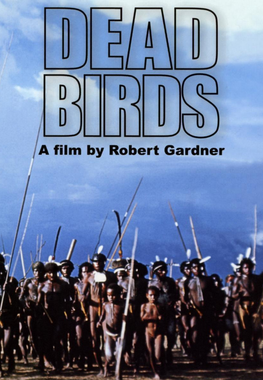
Dead Birds is a 1963 American documentary film by Robert Gardner about the ritual warfare cycle of the Dugum Dani people who live in the Baliem Valley in present-day Highland Papua province on the western half of the island of New Guinea in Indonesia. The film presents footage of battles between the Willihiman-Wallalua confederation (Wiligima-Alula) of Gutelu alliance (Kurulu) and the Wittaia alliance with scenes of the funeral of a small boy killed by a raiding party, the women's work that goes on while battles continue, and the wait for enemy to appear. In 1964 the film received the Grand Prize "Marzocco d'Oro" at the 5th Festival dei Popoli rassegna internazionale del film etnografico e sociologico in Florence, Italy, the Robert J. Flaherty Award given by the City College of New York, and was a featured film at the Melbourne Film Festival. In 1998, Dead Birds was included in the annual selection of 25 motion pictures added to the National Film Registry of the Library of Congress, being deemed "culturally, historically, or aesthetically significant" and recommended for preservation. Dead Birds has come to hold canonical status among ethnographic films.
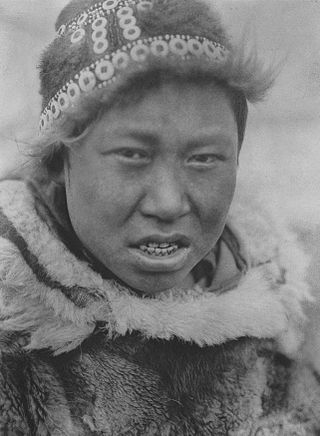
The Yupik are a group of Indigenous or Aboriginal peoples of western, southwestern, and southcentral Alaska and the Russian Far East. They are related to the Inuit and Iñupiat. Yupik peoples include the following:
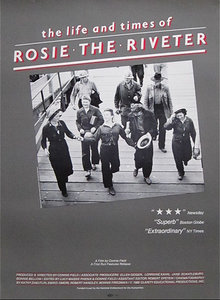
The Life and Times of Rosie the Riveter is a 1980 documentary film and the first movie made by Connie Field, about the American women who went to work during World War II to do "men's jobs." In 1996, it was selected for preservation in the United States National Film Registry by the Library of Congress as being "culturally, historically, or aesthetically significant."

The River is a 1938 short documentary film which shows the importance of the Mississippi River to the United States, and how farming and timber practices had caused topsoil to be swept down the river and into the Gulf of Mexico, leading to catastrophic floods and impoverishing farmers. It ends by briefly describing how the Tennessee Valley Authority project was beginning to reverse these problems.
Precious Images is a 1986 short film directed by Chuck Workman. It features approximately 470 half-second-long splices of movie moments through the history of American film. Some of the clips are organized by genre and set to appropriate music; musicals, for example, are accompanied by the title song from Singin' in the Rain. Films featured range chronologically from The Great Train Robbery (1903) to Rocky IV (1985), and range in subject from light comedies to dramas and horror films.

Antonia: A Portrait of the Woman is a 1974 documentary about symphony conductor Antonia Brico, including her struggle against gender bias in her profession. The film was directed by Judy Collins and Jill Godmilow. It was nominated for an Academy Award for Best Documentary Feature.
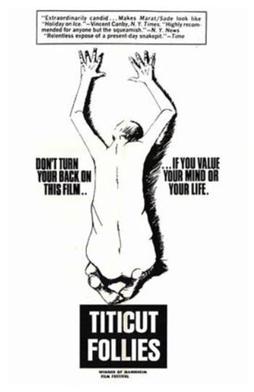
Titicut Follies is a 1967 American direct cinema documentary film produced, written, and directed by Frederick Wiseman and filmed by John Marshall. It deals with the patient-inmates of Bridgewater State Hospital for the Criminally Insane, a Massachusetts Correctional Institution in Bridgewater, Massachusetts. The title is taken from that of a talent show put on by the hospital staff. Titicut is the Wampanoag name for the nearby Taunton River.

John Eliot Sturges was an American film director. His films include Bad Day at Black Rock (1955), Gunfight at the O.K. Corral (1957), The Magnificent Seven (1960), The Great Escape (1963), and Ice Station Zebra (1968). In 2013 and 2018, respectively, The Magnificent Seven and Bad Day at Black Rock were selected for preservation in the United States National Film Registry by the Library of Congress as being "culturally, historically, or aesthetically significant".

Garlic Is as Good as Ten Mothers is a 1980 documentary film about garlic directed by Les Blank. Its official premiere was at the 1980 Berlin Film Festival.
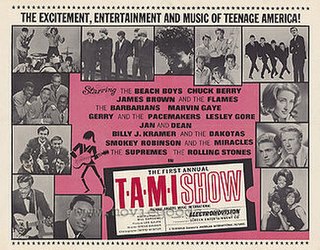
T.A.M.I. Show is a 1964 concert film released by American International Pictures. It includes performances by numerous popular rock and roll and R&B musicians from the United States and England. The concert was held at the Santa Monica Civic Auditorium on October 28 and 29, 1964. Free tickets were distributed to local high school students. The acronym "T.A.M.I." was used inconsistently in the show's publicity to mean both "Teenage Awards Music International" and "Teen Age Music International".

The Yupʼik or Yupiaq and Yupiit or Yupiat (pl), also Central Alaskan Yupʼik, Central Yupʼik, Alaskan Yupʼik, are an Indigenous people of western and southwestern Alaska ranging from southern Norton Sound southwards along the coast of the Bering Sea on the Yukon-Kuskokwim Delta and along the northern coast of Bristol Bay as far east as Nushagak Bay and the northern Alaska Peninsula at Naknek River and Egegik Bay. They are also known as Cupʼik by the Chevak Cupʼik dialect-speaking people of Chevak and Cupʼig for the Nunivak Cupʼig dialect-speaking people of Nunivak Island.
Sponsored film, or ephemeral film, as defined by film archivist Rick Prelinger, is a film made by a particular sponsor for a specific purpose other than as a work of art: the films were designed to serve a specific pragmatic purpose for a limited time. Many of the films are also orphan works since they lack copyright owners or active custodians to guarantee their long-term preservation.

Before Stonewall: The Making of a Gay and Lesbian Community is a 1984 American documentary film about the LGBT community prior to the 1969 Stonewall riots. It was narrated by author Rita Mae Brown, directed by Greta Schiller, co-directed by Robert Rosenberg, and co-produced by John Scagliotti and Rosenberg, and Schiller. It premiered at the 1984 Toronto International Film Festival and was released in the United States on June 27, 1985. In 1999, producer Scagliotti directed a companion piece, After Stonewall. To celebrate the 30th anniversary of the Teddy Awards, the film was shown at the 66th Berlin International Film Festival in February 2016. To commemorate the 50th anniversary of the Stonewall riots in 2019, the film was restored and re-released by First Run Features in June 2019. Later in 2019, the film was selected by the Library of Congress for preservation in the United States National Film Registry for being "culturally, historically, or aesthetically significant".

The National Film Registry (NFR) is the United States National Film Preservation Board's (NFPB) collection of films selected for preservation, each selected for its historical, cultural and aesthetic contributions since the NFPB's inception in 1988.
Who Killed Vincent Chin? is a 1987 American documentary film produced and directed by Christine Choy and Renee Tajima-Peña that recounts the murder of Vincent Chin. It was nominated for the Academy Award for Best Documentary Feature. It was later broadcast as part of the PBS series POV.
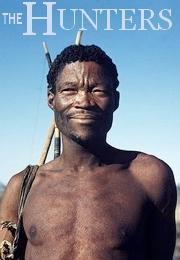
The Hunters is a 1957 ethnographic film that documents the efforts of four !Kung men to hunt a giraffe in the Kalahari Desert of Namibia. The footage was shot by John Marshall during a Smithsonian-Harvard Peabody sponsored expedition in 1952–53. In addition to the giraffe hunt, the film shows other aspects of !Kung life at that time, including family relationships, socializing and storytelling, and the hard work of gathering plant foods and hunting for small game.
Study of a River is a 1997 experimental film directed by Peter Hutton.

Freedom Riders is a 2010 American historical documentary film, produced by Firelight Media for the twenty-third season of American Experience on PBS. The film is based in part on the book Freedom Riders: 1961 and the Struggle for Racial Justice by historian Raymond Arsenault. Directed by Stanley Nelson, it marked the 50th anniversary of the first Freedom Ride in May 1961 and first aired on May 16, 2011. It was funded in part by the National Endowment for the Humanities. The film was also featured on The Oprah Winfrey Show program titled, Freedom Riders: 50th Anniversary. Nelson was helped in the making of the documentary by Arsenault and Derek Catsam, an associate professor at the University of Texas of the Permian Basin.
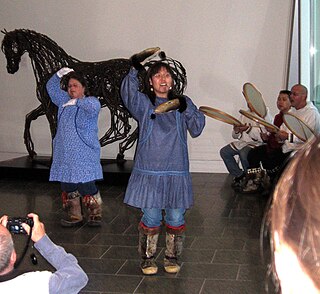
Yup'ik dance or Yuraq, also Yuraqing is a traditional Eskimo style dancing form usually performed to songs in Yup'ik, with dances choreographed for specific songs which the Yup'ik people of southwestern Alaska. Also known as Cup'ik dance for the Chevak Cup'ik dialect speaking Yup'ik of Chevak and Cup'ig dance for the Nunivak Cup'ig dialect speaking Yup'ik of Nunivak Island. Yup'ik dancing is set up in a very specific and cultural format. Typically, the men are in the front, kneeling and the women stand in the back. The drummers are in the very back of the dance group. Dance is the heart of Yup’ik spiritual and social life. Traditional dancing in the qasgiq is a communal activity in Yup’ik tradition. The mask (kegginaquq) was a central element in Yup'ik ceremonial dancing.
References
- ↑ "Faculty Member's Film Named to National Film Registry". NewsCenter. University at Buffalo. 2007-01-12. Retrieved 2008-09-11.
- ↑ Baily, John (1989). "Review: Uksuum Cauyai: The Drums of Winter by Sarah Elder; Leonard Kamerling". Yearbook for Traditional Music . 21: 168–170. doi:10.2307/767800. JSTOR 767800. S2CID 191364317.
- ↑ "Librarian of Congress Adds Home Movie, Silent Films and Hollywood Classics to Film Preservation List". Library of Congress. Retrieved 2020-09-29.
- ↑ "Complete National Film Registry Listing". Library of Congress. Retrieved 2020-09-29.